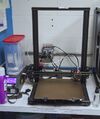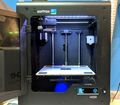Category:3D Printing: Difference between revisions
m (added to activities category) |
m (→3D Printers) |
||
| (10 intermediate revisions by the same user not shown) | |||
| Line 2: | Line 2: | ||
== Equipment == | == Equipment == | ||
The [[Creality_CR10S|Creality CR10S]] is placed at a lower priority. MAG Laboratory tries to keep either the Creality or the IIIP printing. | === 3D Printers === | ||
The [[Zortrax_M200_3D_Printer | Zortrax M200]] is set aside as a "known good" printer, and it is placed at a high operating priority. Every printer other than the Zortrax is capable of PLA. With that said, some of its capabilities are considered "legacy," and large parts are not recommended since they have a high probability of failure. Many ad-hoc modifications have been implemented during prints on the Zortrax for warp-related failure prevention. | |||
The [[Creality_CR10S|Creality CR10S]] is placed at a lower priority. The Zortrax is kept as close to "always printing" as possible, and MAG Laboratory tries to keep either the Creality or the IIIP printing. | |||
The [[Monoprice_Maker_Select_3D_Printer_V2|IIIP]] is slated for trade once the Yangbot's proposed Prusa XL donation arrives. The Yangbot will receive the IIIP, and MAG Laboratory will receive a Prusa XL. | The [[Monoprice_Maker_Select_3D_Printer_V2|IIIP]] is slated for trade once the Yangbot's proposed Prusa XL donation arrives. The Yangbot will receive the IIIP, and MAG Laboratory will receive a Prusa XL. | ||
The [[Pulse XE]] is a newer arrival at MAG Laboratory. It has recently been commissioned for use at the space. | |||
{{Template:3D_DigitalFabrication}} | {{Template:3D_DigitalFabrication}} | ||
=== Support Equipment === | |||
The filament dehydrator works and should be paired with the filament dehydration hood while in use. | |||
== Members == | == Members == | ||
| Line 15: | Line 23: | ||
== Procedures == | == Procedures == | ||
The following are some of the recommended procedures that MAG Laboratory follows in order to ensure "good" 3d printing quality. | The following are some of the recommended procedures that MAG Laboratory follows in order to ensure "good" 3d printing quality. | ||
=== 3D Printing === | |||
The 3D printers do not have usage restrictions or certification tests and may be used by nearly anybody. | |||
'''Please watch your 3D prints through the first layer if you are printing with MAG Laboratory.''' Your prints are much more likely to fail and do damage to our printers on the first layer. | |||
=== Filament Dehydration === | === Filament Dehydration === | ||
MAG Laboratory has made it a priority to keep filament dry, so dry boxes are used for most printing operations. Symptoms of filament hydration include but are not limited to: filament running while the printer is idle, filament stringing, filament bubbling, print | MAG Laboratory has made it a priority to keep filament dry, so dry boxes are used for most printing operations. Symptoms of filament hydration include but are not limited to: filament running while the printer is idle, filament stringing, filament bubbling, print porosity, print bubbling, and print failure. PLA filament that is not dehydrated has a tendency to be very brittle and may break during printing or in storage. Filament that is not confirmed to a dry box will often be placed on a 24hr+ filament dehydration cycle. PLA dehydration is often run longer since dehydration can not be performed at a higher temperature. | ||
==== Dehydration Instructions ==== | |||
Place filament dehydrator in cardboard box to assist in temperature maintenance and insulation. Place filament in dehydrator. | |||
Set dehydrator to filament temperature. Turn on dehydrator. | |||
Run dehydrator for at least the specified filament dehydration time. | |||
{| class="wikitable" | |||
!Filament | |||
! Temperature | |||
!Time | |||
|- | |||
|PLA | |||
|35-40C | |||
|24h+ | |||
|- | |||
|ABS | |||
|60-65C | |||
|6h | |||
|- | |||
|(untested) PETG | |||
|50-55C | |||
|12h | |||
|} | |||
=== Printer Qualification === | === Printer Qualification === | ||
| Line 24: | Line 63: | ||
When bed leveling fine-tuning is desired, a [https://www.thingiverse.com/thing:2187071 bed leveling print] is performed. | When bed leveling fine-tuning is desired, a [https://www.thingiverse.com/thing:2187071 bed leveling print] is performed. | ||
As of 2023-03-10, an axis test has been proposed. This involves printing the [https://www.printables.com/model/275910-yacs-yet-another-calibration-square YACS] and measuring its axes for printer axis misalignment. | |||
=== Preventive Printer Maintenance === | === Preventive Printer Maintenance === | ||
| Line 33: | Line 74: | ||
== History == | == History == | ||
MAG Laboratory had a first-generation [https://reprap.org/wiki/MendelMax RepRap MendelMax 1.0] 3d printer. | MAG Laboratory had a first-generation [https://reprap.org/wiki/MendelMax RepRap MendelMax 1.0] 3d printer. | ||
The 3D printers have been in the electronics room. In the past, there was a server rack that the 3D printers lived inside. In 2021, it was deemed that the server rack was too cramped and did not present the 3D printers to potential users. The makerspace was then reorganized and the 3D printers are now presented in their current state on the table at the back of the electronics room. | |||
MAG Laboratory eventually received more 3d printer donations since members had printers that they did not use at home. | MAG Laboratory eventually received more 3d printer donations since members had printers that they did not use at home. | ||
| Line 41: | Line 84: | ||
[[Category:Activities]] | [[Category:Activities]] | ||
[[Category:Equipment]] | |||
Latest revision as of 09:40, 12 May 2023
At MAG Laboratory, we maintain a collection of 3d printers assigned to different capabilities and materials. This page serves as an overview for our history, procedures, and equipment.
Equipment
3D Printers
The Zortrax M200 is set aside as a "known good" printer, and it is placed at a high operating priority. Every printer other than the Zortrax is capable of PLA. With that said, some of its capabilities are considered "legacy," and large parts are not recommended since they have a high probability of failure. Many ad-hoc modifications have been implemented during prints on the Zortrax for warp-related failure prevention.
The Creality CR10S is placed at a lower priority. The Zortrax is kept as close to "always printing" as possible, and MAG Laboratory tries to keep either the Creality or the IIIP printing.
The IIIP is slated for trade once the Yangbot's proposed Prusa XL donation arrives. The Yangbot will receive the IIIP, and MAG Laboratory will receive a Prusa XL.
The Pulse XE is a newer arrival at MAG Laboratory. It has recently been commissioned for use at the space.
Support Equipment
The filament dehydrator works and should be paired with the filament dehydration hood while in use.
Members
The current lead of 3D printing activities defaults to the Chief Technical Officer since the suggested 3D printing position is not filled.
Procedures
The following are some of the recommended procedures that MAG Laboratory follows in order to ensure "good" 3d printing quality.
3D Printing
The 3D printers do not have usage restrictions or certification tests and may be used by nearly anybody.
Please watch your 3D prints through the first layer if you are printing with MAG Laboratory. Your prints are much more likely to fail and do damage to our printers on the first layer.
Filament Dehydration
MAG Laboratory has made it a priority to keep filament dry, so dry boxes are used for most printing operations. Symptoms of filament hydration include but are not limited to: filament running while the printer is idle, filament stringing, filament bubbling, print porosity, print bubbling, and print failure. PLA filament that is not dehydrated has a tendency to be very brittle and may break during printing or in storage. Filament that is not confirmed to a dry box will often be placed on a 24hr+ filament dehydration cycle. PLA dehydration is often run longer since dehydration can not be performed at a higher temperature.
Dehydration Instructions
Place filament dehydrator in cardboard box to assist in temperature maintenance and insulation. Place filament in dehydrator.
Set dehydrator to filament temperature. Turn on dehydrator.
Run dehydrator for at least the specified filament dehydration time.
| Filament | Temperature | Time |
|---|---|---|
| PLA | 35-40C | 24h+ |
| ABS | 60-65C | 6h |
| (untested) PETG | 50-55C | 12h |
Printer Qualification
The usual low-reliability qualification print is low poly cat. Printers must complete the cat print at an acceptable quality to meet the minimum reliability level of testing.
As of 2022-09-03, a "bed adhesion testing" print of four solid-infill bicycle handlebar shims has been proposed.
When bed leveling fine-tuning is desired, a bed leveling print is performed.
As of 2023-03-10, an axis test has been proposed. This involves printing the YACS and measuring its axes for printer axis misalignment.
Preventive Printer Maintenance
Ad-hoc preventive maintenance is performed on machines with sliding axes. Strategically placed globs of grease are dripped onto the linear axes while the printer is in operation. At times, a "grease on - grease off" approach is taken to remove contaminated grease.
Printer-out Maintenance
At times, printers will fail. MAG Laboratory takes a first-qualified-person approach to unscheduled 3d printer maintenance. When a printer-out event occurs, the stakeholders of the current 3d print queue are notified and printer repairs are undertaken. At times, printers will be placed on extended-offline for failure to meet qualification.
History
MAG Laboratory had a first-generation RepRap MendelMax 1.0 3d printer.
The 3D printers have been in the electronics room. In the past, there was a server rack that the 3D printers lived inside. In 2021, it was deemed that the server rack was too cramped and did not present the 3D printers to potential users. The makerspace was then reorganized and the 3D printers are now presented in their current state on the table at the back of the electronics room.
MAG Laboratory eventually received more 3d printer donations since members had printers that they did not use at home.
In November 2019, MAG Laboratory received a server rack that it converted into shelving for its 3d printers.
In June 2021, MAG Laboratory moved its printers to the table at the rear of the electronics room. Additionally, the mendelmax was returned to Trent.
Pages in category "3D Printing"
The following 5 pages are in this category, out of 5 total.






